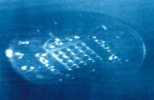What's happening in production
Seeing through crude; better practicesThe oil industry routinely uses conventional video cameras for downhole diagnostics. They are effective only if the borehole is continuously flushed with clean brine, because the cameras cannot see through oil. The cost of flushing is huge, and delays caused by bringing pump and filter sets to the rig mean that downhole camera use is often rejected. UK-based Proneta has combined its expertise in space-imaging technologies and its knowledge of oilfield industry needs to create an imaging technology that can take pictures of oil-well interiors. The company secured part sponsorship from the European Commission for the exploratory work. Conoco provided a set of oil samples for experimental use. The idea was to identify certain characteristics of oil that were never before exploited. The company knew that detectors with these special characteristics had already been developed for use on meteorological satellites such as ESA’s ENVISAT and ERS missions. Based on that component technology and test results, useful images have been achieved in an oil-filled cylinder, and equipment can probably be engineered to withstand the severe environment and tight constraints on size and bandwidth. The company has filed key patents. Potential applications include:
The next phase will be to build a full-scale demonstrator and image real targets. These will be damaged casing and tubulars in a 12-in. diameter, 10-ft high, crude-filled tank. The subsequent phase would likely be to team with a company that already builds conventional downhole video cameras as well as an oilfield service company. The company already has offers of test wells from major oil companies when that stage is reached. Better practices. An interesting article in BP Amoco’s Well Connected detailed the company’s experience on the Bruce Phase II Subsea project in the North Sea. Completion overruns on the first three wells ranged from 158% to 200%, while nonproductive time was in the 20% to 26% range. Several changes were then made to the team and its approach. The influence of the Contractor Alliance was reduced, and new ideas from other projects were sought. A process called Radical De-Scoping involved four different teams and identified 224 potential improvements. Ideas that were common to all four groups were given priority. Based on experiences from the first three wells, Technical Limit Analysis was performed to identify lost / trouble time and risks. Combining De-Scoping and Technical Limits identified ways to reduce complexity and speed up operations. Finally, the new procedures were incorporated into a Monte Carlo model, called Crystal Ball, to identify the risked times for cost reduction.
From De-Scoping, of the 41 ideas that survived and were slated for further investigation, several were implemented immediately. These included:
Technical Limits revealed numerous small tasks that could be eliminated or combined with others, e.g.:
There were also new methods of optimizing the completion, e.g., perforate with smaller-OD guns (2-3/4 in. vs. 3-3/8 in.) to allow longer gun lengths and maximize gun length to the limit. Each of these reduces the number of gun runs. Rig design had an effect as well. Unfortunately, the rig utilized had sponsons added and experienced excessive heave during winter completions. Shifting completions out of winter and use of a newer, less heave-sensitive rig would help, although these have not been implemented. Implementing such changes on the next trio of completions resulted in reduced per-well completion time to an average of 33 days from the previous 75 days. Mechanical nonproductive time was reduced to a per-well average of just seven days – less than half of the previous 16 days. There is much more to this report, and its authors are willing to share their knowledge with appropriate parties. Write Dan Gibson at: gibsondh@bp.com That’s a long gun. Baker Oil Tools claims to
have recently set a world record for the category of longest slimhole perforating gun
assembly. During a horizontal completion for Petroleum Development Oman, a 987-ft-long,
1-9/16-in.-dia. perforating assembly was hydraulically fired with top shot at 5,597 ft. The
gun was tubing-conveyed using Baker Hughes INTEQ’s coiled-tubing drilling rig.
|




